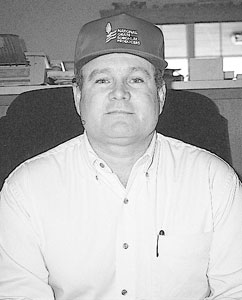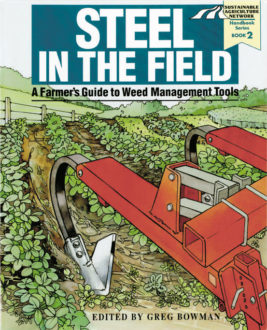
Dryland Crops: The Farmers
Tillage in the Texas Panhandle: Matching Wits With Clay, Wind and Drought
Dale Artho
Wildorado, Texas
- 3,600 acres
- Grain sorghum, wheat, fallow (in thirds)
- Clay loam soils
- Half of acreage receives supplemental furrow irrigation
- 17-19 inches annual rainfall
- sporadic, intense thundershowers
- stocker cattle on winter-grazed wheat
Weed management highlights
Strategies: inter-row cultivation... winter wheat grazing... fallow mulch tillage... limited herbicides (spot-spray, burndown and banded pre-emerge)... narrow rows for quick canopy... staggered planting dates to keep weed-control needs within labor/machine capacity... summer-annual forage crop
Tools: cultivators with knives, sweeps and furrow openers... mechanical guidance... chisel plow with wide sweeps... fallow-managing tool with wide sweeps
Farming on the High Plains of the Texas panhandle is about true grit, about taking on odds that farmers elsewhere would call gambling.
Dale Artho's clay loam soil can harden like concrete, or crust to shed water that crops need to survive the baking summer sun. Summer rains come in torrents - when they come at all. Virtually any cropping choice can be right, or wrong, depending on the wind or the rain or the markets.
'You just hope you do the right thing at least 50 percent of the time,' says Artho. He uses high-residue cultivators, conservation tillage and crop spacing to whittle down his use of herbicides. He's gone to mulch tillage and 240-foot-wide crop strips to check wind erosion. Anything else that cuts risk, saves moisture or boosts yields on his mile-square sections of land is a welcome addition.
Much like vegetable growers in sunny California, High Plains farmers can depend on a rain-free, early summer planting season 9 years out of 10. Artho plants sorghum with a 10-inch herbicide band over the row. He plants two rows, 30 inches apart, on 60-inch-wide beds that are 5 inches high. Each row is 15 inches in from a side. Dry weather usually keeps inter-row weed pressure low early in the season but also inhibits herbicide action.
To help sorghum germination, he designs all tillage passes throughout the year to maximize soil moisture for this early summer season. No-till systems he tried often left his soil too unmanageable during this period and led to weed problems.
To minimize the risk of encountering more weed pressure than his steel could handle, Artho limits how many acres of sorghum will need to be cultivated at one time. He staggers planting times for several weeks starting in late April (on irrigated fields) through late June (dryland) to facilitate timely weed control.
'When this plan works, I've got a great window to cultivate,' he explains. He has two cultivators - one 16-row and one eight-row - for the 1,200 acres of sorghum he plants each year, so he needs to stretch out the weeding time period.
He built the larger cultivator, starting with a 40-foot, 5x7-inch folding toolbar. He added 20-inch flat sweeps on 1.25 x 3-inch straight shanks, stabilizer coulters and metal guide cones to run in the furrows left at planting. His cultivation trigger is the arrival of witchgrass - also called Colorado grass or ticklegrass (Panicum capillare L.). 'It comes up, explodes in growth and sucks water from the soil at a staggering rate,' Artho says. 'In a single day a field can go from being too wet to being too dry. And the grass has to be controlled, or it will cripple production.'
Other weedy invaders in the sorghum are pigweed (Palmer amaranth), kochia and bindweed. He can cultivate with sweeps or use herbicide, adding either option to other required tillage at no extra tractor cost - but herbicide would be an added expense.
One job is to improve water retention between the two rows of sorghum on each bed. His Roll-A-Cone diker intermittently drags then releases paddles of its large spider wheel to create mini-reservoirs. Trapping water in the gallon-sized depressions gives it more time to soak into the subsoil. Artho's 40-percent-clay loam soil can hold up to 10 inches of precipitation and accept it at 6 inches per hour when the soil surface is open. But that infiltration rate plummets to almost nothing if soil is crusted on top.
The paddle assemblies are attached to a secondary toolbar attached to his cultivator. The depressions prevent rainfall from running off his field and give the soil time to absorb the water. He usually makes this pass when sorghum is 8 to 10 inches tall.
Performing the three-fold tillage operation is his highly valued Hitchcock High Residue Cultivator. The rugged eight-row precision tool was designed for sugarbeet production, one of Artho's former crops. That heritage makes it well-suited to cultivate the flat bed tops and furrows between the beds.
The cultivator's gangs include 20-inch smooth coulters to cut residue; gauge wheels to keep tools gliding at an even depth through the soil; cutaway disks that peel residue and weed seeds away from the rows; thin side-knives (vegetable knives), right-angle types for the flat surfaces and curved types to handle the bed sides; 20-inch, low-profile sweeps to undercut weeds on both sides of the rows; furrow-opener ridging wings (mounted just above the sweeps) to throw soil into the rows for the hilling effect; and more furrow shovels to reshape the furrows between the beds.
The diker creates the mini-reservoirs down the middle of each bed. The pass leaves each sorghum row between two water sources - a furrow for supplemental irrigation and the line of reservoirs to capture any rain through the season. Artho usually supplies water about 35 days after planting when the potential number of seeds per head is being determined. Moisture stress at this time cripples yield.
Holding the cultivator tightly in alignment with the crop rows are thin metal guidance wheels and guide sleds that run against the 5-inch high sides of the raised beds. 'This was Hitchcock's 'pre-electronic' guidance system, and it still works fine,' says Artho.
Artho raises forage wheat for his stocker cattle and grain wheat for harvest. Both types of fields will need ticklegrass control by August. He leaves all the stubble on the surface to prevent wind erosion and to build soil organic matter. Recently, however, he's had little biomass to work with. In '94, '95 and '96, drought kept stubble under 6 inches tall on some of his farms, while late spring freezes or hail arrested stalks at 12 to 18 inches on others. He explains that in a 'good year,' the area's dryland wheat yields 30 bushels per acre.
He uses a Quinstar Fallowmaster for the August field pass. It has two ranks of chisel-plow shanks mounted on a braced frame. The tool is structurally stronger than a field cultivator but is lighter than a blade plow. It pulls staggered 26-inch sweeps spaced 20 inches apart.
The pass kills weeds, leaves residue to trap snow, and opens up the soil surface to let water infiltrate. Afterward, there's enough residue left (70 to 85 percent in a good year) to minimize moisture loss. If rains sprout more weeds, Artho uses herbicide to maintain the residue cover.
In spring he runs the Fallowmaster again. He hitches a tank caddy on to spot-spray bindweed (Convolvulus arvensis L., called morning-glory in some regions).
Artho finds technique is important in this combination pass. A postemergent herbicide works best where the weed is undisturbed and not covered with soil particles. When he approaches a patch of weeds, he slows down, turns on wide-angle nozzles and raises the sweeps out of the soil - all before he reaches the target weeds. Once he's past the patch, he drops the sweeps then turns off the sprayer.
The care with which Artho interweaves tillage and herbicides in this maneuver symbolizes his overall approach to weed control. 'I'm controlling weeds with tools to manage moisture, and I use economical chemicals when I have to,' he muses. 'It's a blend that works in my predictably unpredictable, extreme conditions.'
